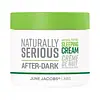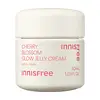What's inside
What's inside
 Key Ingredients
Key Ingredients

 Benefits
Benefits

 Concerns
Concerns

 Ingredients Side-by-side
Ingredients Side-by-side

Water
Skin ConditioningStearic Acid
CleansingGlycerin
HumectantCaprylic/Capric Triglyceride
MaskingGlyceryl Stearate
EmollientGlyceryl Stearate Se
EmulsifyingC9-12 Alkane
SolventBetaine
HumectantInositol
HumectantCetearyl Alcohol
EmollientUndecane
EmollientButyrospermum Parkii Butter
Skin ConditioningPropanediol
SolventSqualane
EmollientPyrus Malus Fruit Extract
Skin ConditioningAspalathus Linearis Leaf Extract
Skin ConditioningLycium Barbarum Fruit Extract
AstringentPunica Granatum Extract
AstringentVitis Vinifera Seed Extract
AntimicrobialLeuconostoc/Radish Root Ferment Filtrate
AntimicrobialCamellia Sinensis Leaf Extract
AntimicrobialApium Graveolens Seed Extract
AntioxidantLinum Usitatissimum Seed Extract
PerfumingAngelica Archangelica Root Extract
MaskingHelianthus Annuus Seed Oil
EmollientColloidal Oatmeal
AbsorbentAllantoin
Skin ConditioningCeramide NP
Skin ConditioningSodium Hydroxide
BufferingTocopheryl Acetate
AntioxidantTocopherol
AntioxidantSodium Phytate
Sorbitan Trioleate
EmulsifyingXanthan Gum
EmulsifyingTridecane
PerfumingCoco-Caprylate/Caprate
EmollientPentylene Glycol
Skin ConditioningPhenethyl Alcohol
MaskingLimonene
PerfumingLinalool
PerfumingCitral
PerfumingCitronellol
PerfumingGeraniol
PerfumingParfum
MaskingWater, Stearic Acid, Glycerin, Caprylic/Capric Triglyceride, Glyceryl Stearate, Glyceryl Stearate Se, C9-12 Alkane, Betaine, Inositol, Cetearyl Alcohol, Undecane, Butyrospermum Parkii Butter, Propanediol, Squalane, Pyrus Malus Fruit Extract, Aspalathus Linearis Leaf Extract, Lycium Barbarum Fruit Extract, Punica Granatum Extract, Vitis Vinifera Seed Extract, Leuconostoc/Radish Root Ferment Filtrate, Camellia Sinensis Leaf Extract, Apium Graveolens Seed Extract, Linum Usitatissimum Seed Extract, Angelica Archangelica Root Extract, Helianthus Annuus Seed Oil, Colloidal Oatmeal, Allantoin, Ceramide NP, Sodium Hydroxide, Tocopheryl Acetate, Tocopherol, Sodium Phytate, Sorbitan Trioleate, Xanthan Gum, Tridecane, Coco-Caprylate/Caprate, Pentylene Glycol, Phenethyl Alcohol, Limonene, Linalool, Citral, Citronellol, Geraniol, Parfum
Water
Skin ConditioningGlycerin
HumectantPropanediol
SolventDipropylene Glycol
HumectantNiacinamide
SmoothingBetaine
Humectant1,2-Hexanediol
Skin ConditioningCarbomer
Emulsion StabilisingTromethamine
BufferingSodium Metaphosphate
BufferingAmmonium Acryloyldimethyltaurate/Beheneth-25 Methacrylate Crosspolymer
Emulsion StabilisingEthylhexylglycerin
Skin ConditioningParfum
MaskingPrunus Yedoensis Leaf Extract
Skin ConditioningTocopherol
Antioxidant
 Reviews
Reviews

Ingredients Explained
These ingredients are found in both products.
Ingredients higher up in an ingredient list are typically present in a larger amount.
Betaine is a common humectant (a substance that promotes retention of moisture). It's known to be gentle on the skin and can help balance hydration.
This ingredient is best for improving hydration and soothing irritated skin. Studies also show it helps even out skin tone.
Fun fact: Betaine is naturally created in the skin and body. The kind found within cosmetic products can be either plant-derived or synthetic.
Another name for betaine is trimethylglycine.
Learn more about BetaineGlycerin is already naturally found in your skin. It helps moisturize and protect your skin.
A study from 2016 found glycerin to be more effective as a humectant than AHAs and hyaluronic acid.
As a humectant, it helps the skin stay hydrated by pulling moisture to your skin. The low molecular weight of glycerin allows it to pull moisture into the deeper layers of your skin.
Hydrated skin improves your skin barrier; Your skin barrier helps protect against irritants and bacteria.
Glycerin has also been found to have antimicrobial and antiviral properties. Due to these properties, glycerin is often used in wound and burn treatments.
In cosmetics, glycerin is usually derived from plants such as soybean or palm. However, it can also be sourced from animals, such as tallow or animal fat.
This ingredient is organic, colorless, odorless, and non-toxic.
Glycerin is the name for this ingredient in American English. British English uses Glycerol/Glycerine.
Learn more about GlycerinParfum is a catch-all term for an ingredient or more that is used to give a scent to products.
Also called "fragrance", this ingredient can be a blend of hundreds of chemicals or plant oils. This means every product with "fragrance" or "parfum" in the ingredients list is a different mixture.
For instance, Habanolide is a proprietary trade name for a specific aroma chemical. When used as a fragrance ingredient in cosmetics, most aroma chemicals fall under the broad labeling category of “FRAGRANCE” or “PARFUM” according to EU and US regulations.
The term 'parfum' or 'fragrance' is not regulated in many countries. In many cases, it is up to the brand to define this term.
For instance, many brands choose to label themselves as "fragrance-free" because they are not using synthetic fragrances. However, their products may still contain ingredients such as essential oils that are considered a fragrance by INCI standards.
One example is Calendula flower extract. Calendula is an essential oil that still imparts a scent or 'fragrance'.
Depending on the blend, the ingredients in the mixture can cause allergies and sensitivities on the skin. Some ingredients that are known EU allergens include linalool and citronellol.
Parfum can also be used to mask or cover an unpleasant scent.
The bottom line is: not all fragrances/parfum/ingredients are created equally. If you are worried about fragrances, we recommend taking a closer look at an ingredient. And of course, we always recommend speaking with a professional.
Learn more about ParfumPropanediol is an all-star ingredient. It softens, hydrates, and smooths the skin.
It’s often used to:
Propanediol is not likely to cause sensitivity and considered safe to use. It is derived from corn or petroleum with a clear color and no scent.
Learn more about PropanediolTocopherol (also known as Vitamin E) is a common antioxidant used to help protect the skin from free-radicals and strengthen the skin barrier. It's also fat soluble - this means our skin is great at absorbing it.
Vitamin E also helps keep your natural skin lipids healthy. Your lipid skin barrier naturally consists of lipids, ceramides, and fatty acids. Vitamin E offers extra protection for your skin’s lipid barrier, keeping your skin healthy and nourished.
Another benefit is a bit of UV protection. Vitamin E helps reduce the damage caused by UVB rays. (It should not replace your sunscreen). Combining it with Vitamin C can decrease sunburned cells and hyperpigmentation after UV exposure.
You might have noticed Vitamin E + C often paired together. This is because it is great at stabilizing Vitamin C. Using the two together helps increase the effectiveness of both ingredients.
There are often claims that Vitamin E can reduce/prevent scarring, but these claims haven't been confirmed by scientific research.
Learn more about TocopherolWater. It's the most common cosmetic ingredient of all. You'll usually see it at the top of ingredient lists, meaning that it makes up the largest part of the product.
So why is it so popular? Water most often acts as a solvent - this means that it helps dissolve other ingredients into the formulation.
You'll also recognize water as that liquid we all need to stay alive. If you see this, drink a glass of water. Stay hydrated!
Learn more about Water